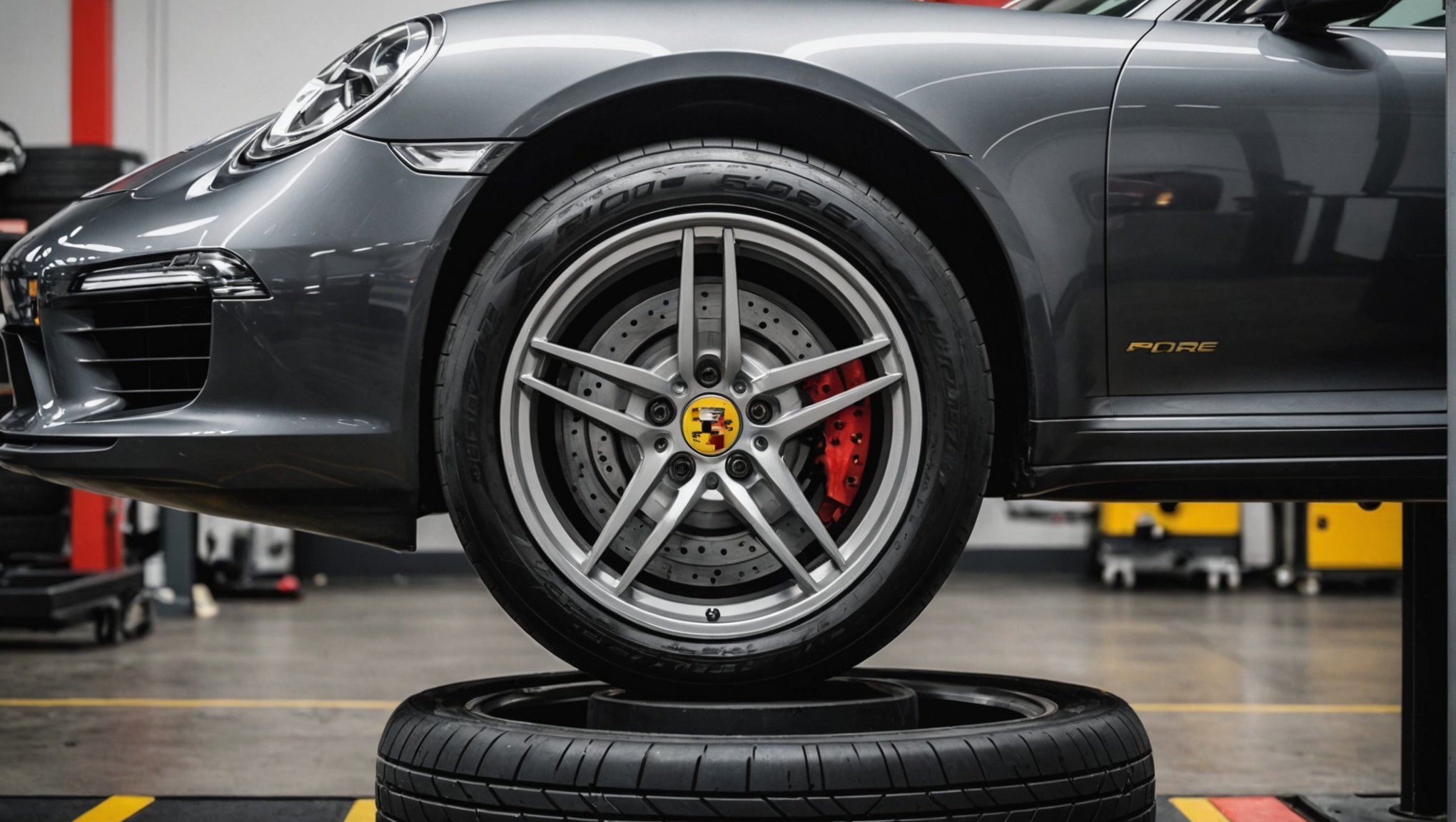Mastering Tire Balancing for Porsche 911: Unlocking Smooth High-Speed Performance
When it comes to the Porsche 911, one of the most iconic sports cars on the market, every detail counts, especially when it comes to high-speed performance. Among the various factors that contribute to a smooth and powerful driving experience, tire balancing stands out as a crucial element. Here’s a deep dive into why and how tire balancing is essential for your Porsche 911.
Understanding the Importance of Tire Balancing
Tire balancing is often overlooked, but it plays a critical role in the overall performance, safety, and longevity of your car’s tires. Here’s why it’s so important:
This might interest you : Maximize Your Nissan 350Z’s Performance: A Guide to Enhancing Airflow with a Cold Air Intake System
- Smooth Ride: Unbalanced tires can cause vibrations that make the driving experience uncomfortable. For a car like the Porsche 911, which is known for its precision and smooth handling, an unbalanced tire can be particularly noticeable.
- Even Wear: Balanced tires wear evenly, extending their lifespan. Uneven wear can lead to premature tire replacement and increased maintenance costs.
- Fuel Efficiency: Properly balanced tires can improve fuel efficiency by reducing the drag and resistance caused by unbalanced tires.
- Safety: Unbalanced tires can affect the car’s stability, especially at high speeds. This is critical for a high-performance car like the Porsche 911, where stability is paramount.
How Tire Balancing Works
Tire balancing involves adjusting the weight distribution of the tire to ensure that it rotates smoothly and evenly. Here’s a step-by-step look at the process:
Dynamic Balancing
Dynamic balancing is the most common method used for high-performance cars like the Porsche 911. This process involves spinning the tire on a balancing machine to detect any imbalances.
Topic to read : Mastering Audi A4 Tire Pressure Sensor Calibration for Peak Performance
- Static vs. Dynamic: Static balancing only checks the tire’s weight distribution when it is stationary, whereas dynamic balancing checks it while the tire is in motion. Dynamic balancing is more accurate and necessary for high-speed vehicles.
- Balancing Machine: The tire is mounted on a balancing machine, which spins the tire and measures the vibrations to identify any imbalances.
- Weight Adjustments: Once the imbalances are identified, small weights are added to the rim to balance the tire.
Tips for DIY Tire Balancing
While it’s recommended to have a professional do the balancing, here are some tips if you decide to do it yourself:
- Use the Right Equipment: Invest in a good quality tire balancing machine.
- Follow Instructions: Read the manual carefully and follow the instructions provided with the balancing machine.
- Check Regularly: Regularly check your tires for balance, especially after driving long distances or if you notice any vibrations.
The Impact on High-Speed Performance
For a car like the Porsche 911, which is designed for high-speed performance, tire balancing is crucial. Here’s how it affects your driving experience:
Stability and Handling
- Weight Transfer: During high-speed cornering, weight transfer occurs, and balanced tires ensure that this transfer happens smoothly without any vibrations or instability.
- Steering Precision: Balanced tires improve steering precision, allowing for sharper turns and better control.
Power and Speed
- Optimized Power Delivery: Balanced tires ensure that the power delivered by the engine is transferred efficiently to the road, enhancing acceleration and overall speed.
- Reduced Vibration: At high speeds, any vibration caused by unbalanced tires can be amplified, affecting the car’s stability. Balanced tires eliminate this issue.
Real-World Examples and Anecdotes
Porsche 911 GT3: A High-Performance Case Study
The Porsche 911 GT3 is a prime example of a car where tire balancing is critical. Here’s what makes it special:
- Rear-Biased Weight Distribution: The 911 GT3 has a rear-biased weight distribution, which requires precise tire balancing to maintain stability and performance.
- High-Performance Tires: The GT3 comes with high-performance tires that are designed to handle the car’s power and speed. These tires need to be balanced to their full potential to deliver the expected performance.
Quotes from Experts
- “Tire balancing is not just about comfort; it’s about performance and safety. For a car like the Porsche 911, it’s essential to ensure that the tires are perfectly balanced to get the best out of the car.” – Coach Dave, Dave Academy
- “When you’re driving at high speeds, the last thing you want is any vibration or instability. Balanced tires give you the confidence to push the car to its limits.” – Porsche Engineer
Practical Insights and Actionable Advice
Here are some practical tips and advice to help you master tire balancing for your Porsche 911:
Regular Maintenance
- Check Tires Regularly: Regularly check your tires for balance, especially after long drives or if you notice any vibrations.
- Use High-Quality Tires: Invest in high-quality tires that are designed for high-performance driving.
Driving Techniques
- Smooth Acceleration: Avoid sudden acceleration, as it can cause weight transfer that may highlight any imbalance in the tires.
- Cornering Techniques: Learn proper cornering techniques to minimize the stress on the tires and maintain balance.
Technology Integration
- Advanced Tire Monitoring Systems: Some modern cars, including the Porsche 911, come with advanced tire monitoring systems that can alert you to any imbalances.
- Edge Technology: Utilize edge technology like sim racing tools (e.g., Forza Motorsport, Gran Turismo) to understand the dynamics of tire balancing in a virtual environment before applying it in real life.
Detailed Bullet Point List: Steps for Tire Balancing
Here is a detailed list of steps to follow for tire balancing:
- Step 1: Gather Equipment
- Tire balancing machine
- Wheel chocks
- Jack and jack stands
- Tire weights
- Step 2: Prepare the Tire
- Remove the tire from the car and clean it thoroughly.
- Ensure the tire is free from any debris or old weights.
- Step 3: Mount the Tire on the Balancing Machine
- Follow the manufacturer’s instructions to mount the tire correctly.
- Ensure the tire is securely fastened to the machine.
- Step 4: Spin the Tire
- Start the balancing machine and let it spin the tire.
- The machine will detect any imbalances and indicate where weights need to be added.
- Step 5: Add Weights
- Use the weights provided with the balancing machine to balance the tire.
- Follow the machine’s instructions for the correct placement of weights.
- Step 6: Recheck the Balance
- Once weights are added, recheck the balance to ensure the tire is perfectly balanced.
- Make any necessary adjustments.
- Step 7: Mount the Tire Back on the Car
- Carefully mount the balanced tire back on the car.
- Ensure it is securely fastened.
Comprehensive Table: Comparison of Tire Balancing Methods
Here is a comparison table of different tire balancing methods:
| Method | Description | Accuracy | Suitability for High-Speed Cars |
|---|---|---|---|
| Static Balancing | Checks weight distribution when the tire is stationary. | Low to Medium | Not recommended for high-speed cars. |
| Dynamic Balancing | Checks weight distribution while the tire is in motion. | High | Recommended for high-speed cars like the Porsche 911. |
| Road Force Balancing | Measures the road force variation (RFV) to balance the tire. | Very High | Ideal for high-performance cars but more expensive. |
Tire balancing is a critical aspect of maintaining the high-speed performance of your Porsche 911. By understanding the importance of tire balancing, knowing how it works, and following practical tips and advice, you can ensure your car delivers the smooth, powerful driving experience it was designed for. Whether you’re a seasoned driver or just starting to explore the world of high-performance driving, mastering tire balancing is a key step in unlocking the full potential of your Porsche 911.













